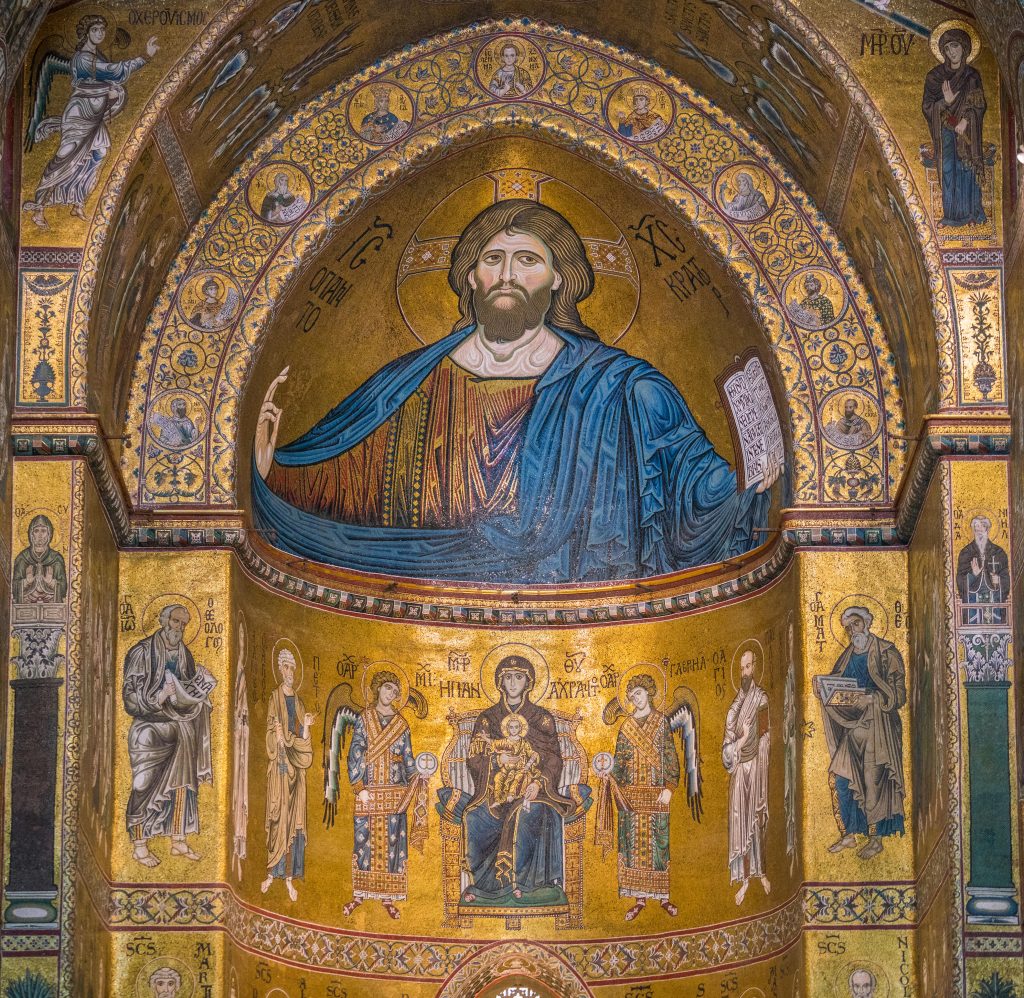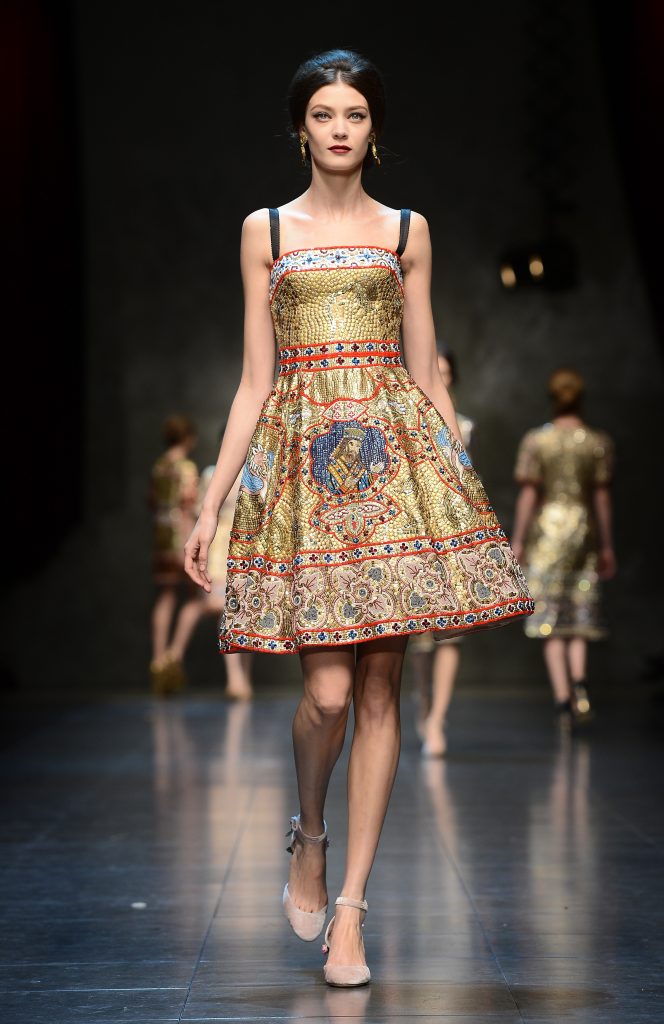2013 Queen Mosaic Dress by Dolce & Gabbana

Religion: Christianity
Time Period: 2010s
Type Of Garment: Dress
Tags: Bible, Cathedral of Monreale, Dolce & Gabbanna, High Fashion, Italy, Mosaic, Rebekah
The Creator:
While a number of fashion houses shy away from religious imagery and motifs, Italian designers Domenico Dolce and Stefano Gabbana often turn to Christianity, specifically Catholicism, as sources of inspiration. For example, in 1998, the duo’s Spring/Summer “Stromboli” collection was the first to revolve entirely around a Christian theme—that of a Marian procession. Aware of possible controversy, they framed the collection as a “celebration of Catholicism” and their Catholic background. They explained,
“We realize that the use of religious images in our collection could be controversial because religion is a very personal matter, which is interpreted differently by each of us. Since fashion is the way in which we express ourselves and convey our feelings, the use of religious images was used to praise the Madonna, whom we strongly believe in. We did not want to offend anyone”
(Neal 2019a: 172).
In the years since, Dolce and Gabbana have returned to Catholic imagery numerous times. This was certainly the case for their Autumn/Winter 2013-2014 collection entitled “Tailored Mosaic.” For this collection, they were inspired by mosaics from the Cathedral of Monreale in Sicily. Born in Sicily, Domenico Dolce attended architecture school in Palermo, near the cathedral. The duo has often highlighted and incorporated Sicilian elements and symbols into their designs (“Carretto Siciliano” 2016). In this collection, then, by focusing on a famous Sicilian cathedral, the designers highlighted two recurring sources of inspiration—Catholicism and Sicily. The collection featured varied designs depicting numerous different cathedral elements, ranging from lions to angels to biblical and human kings. Some garments showcased mosaic-making techniques by piecing gems together into patterns and figures, while others were made of fabrics that replicated mosaic scenes. Garments in solid colors—pure white, bright red, and bold black—and others in tweed highlighted the intricacies and embellishments of the figural mosaic designs (see Neal 2019b).
A brief behind the scenes look at the making and styling of “Tailored Mosaic.”
The Context:
Built in the twelfth century, the Cathedral of Monreale, a recognized UNESCO world heritage site, is known for its Byzantine architecture and style, represented most powerfully in over six thousand square meters of mosaics (Sciortino 2012: 27, 32). Constructed of mosaic tiles, called tesserae, the vibrant figures and scenes are surrounded by a sea of gold (see Figure 1). The effect is overwhelming and astounding. “The synaesthetic interplay of Byzantine architecture, arts, and liturgy so moved witnesses,” writes medievalist Linda Safran, “that a celestial comparison was warranted; this was not the stuff of daily, earthly life.” (Safran 2000, 1). The mosaics, at least ideally, transported medieval worshippers into sacred space and time.

Many of the Cathedral’s mosaics highlight different biblical figures and scenes, as well as early Christian saints and King William II who began the building of the Cathedral. Three levels of biblical mosaics decorate the nave. The highest level features the earliest biblical accounts—the days of creation and the stories of Adam and Eve and their sons. The narratives of Noah and Abraham dominate the second level on the south aisle, while those of Abraham’s son Isaac and grandson Jacob appear on the north side. The third and lowest level depicts the many miracles performed by Jesus. Each mosaic contains details from the biblical events to draw the viewer into the sacred stories. Linda Safran explains that in Byzantine churches “colorful images of holy figures enveloped the worshiper, bringing him or her into their saintly company; precious objects of silver and gold glittered on the altar, reflecting the light of flickering oil lamps and candles; and the elaborately orchestrated liturgical service transfigured the interior” (Safran 2000, 1).
While the cathedral mosaics sought to transport parishioners into the realm of the sacred, many fashion designers—including Chanel, Lagerfeld, Versace, and Valentino— have utilized the Byzantine style to inspire their potential customers and transport them to a place of wonder and awe. The techniques, the shapes, the colors, and the content of Byzantine art and architecture offer fashion designers a variety of inspirational resources. In a similar way, in “Tailored Mosaic” Dolce & Gabbana utilized the technique of mosaic-making and biblical imagery to elevate their designs and highlight the transcendent quality of fashion.
The Object:
The “queen” mosaic dress (see Figure 2) features a woman standing in a doorway looking toward an event—one not depicted on the dress. She wears a long blue dress with gold and orange trim at the neckline, as well as on the sleeves and skirt. Her long blond hair peeks out from a head covering. The doorway surrounds her and makes it clear that she is the focal point of the dress. The scene is made of tesserae that when put together constitute a mosaic design. In this case, unlike many of the other dresses in the collection that showcased elaborate work with beads and gemstones to re-create mosaics, the mosaic is printed on the fabric. The effect is a simpler, less embellished design. Compared with the rich reds and pure whites or the dazzling jewels seen in some of the collection’s other looks, this dress appears muted (see this video to view the whole runway show). This sense is enhanced by the simplicity of the dress’s style—a three-quarter-length hourglass with short sleeves.

The figure on the dress is the biblical Rebekah. Her story is recounted in the book of Genesis. She is the wife of the patriarch Isaac and the mother of twin sons, Esau and Jacob. Beloved by his father Isaac, Esau was a hunter and farmer, while Jacob, favored by his mother Rebekah, “was a quiet man, dwelling in tents” (Genesis 25:27). Toward the end of his life, an aged and blind Isaac asked Esau to bring him fresh game and then receive his final blessing. Having overheard this request, Rebekah went to Jacob and together they created a plan to deceive Isaac and steal his brother Esau’s blessing (Genesis 27). Their plan succeeded and is central to the history of the Israelites as Jacob later, after wrestling with God, became known as Israel and was the father of the twelve tribes of Israel.
At the Cathedral of Monreale, Rebekah appears in three mosaics—watering the camels (a sign that she should be selected as Isaac’s bride), journeying to Isaac, and observing the blessing of Jacob. Rebekah’s appearance in this latter mosaic, seen in Figure 3, appears to provide the inspiration for this Dolce & Gabbana dress. In the mosaic, she wears shades of brown, gold, and white, and stands between Esau and the blessing of Jacob by Isaac. The dress, though, transforms Rebekah’s clothing into various blues and removes the surrounding characters. She stands alone, devoid of context.

The inclusion of more simple and muted designs in the collection provides respite from the opulence of the other looks and prevents it from being too kitschy and over the top (Phelps 2013). Indeed, many fashion critics and observers praised the collection.
Yet, the choice of Rebekah is an interesting one to consider. Why select this figure and mosaic as inspiration? The Dolce & Gabbana store labeled this dress “Queen Mosaic Print Hourglass Dress.” However, the biblical Rebekah was not a queen. Many of the models in the runway show wore crowns (although not with this dress as you can see in Figure 2) and some of the garments featured King William II, whom many observers misidentified as Jesus (see Figure 4). Did Dolce & Gabbana (and their artisans and marketers) know Rebekah’s identity or was she just a pretty mosaic placeholder?
This mislabeling matters because it highlights how fashion designers and the industry more broadly reflect and shape a specific concept of religion—one dominated by visual beauty and artistic wonder, rather than historical depth or contextual continuity. Describing Rebekah on this dress as a “queen” certainly creates coherence with the rest of the collection. Further, while Rebekah figures prominently in accounts of the patriarchs, she does not have a rich iconographic tradition that would make her easily recognizable to the twenty-first century viewer, especially when standing in a doorway removed from any additional contextual clues.

Selecting and mislabeling Rebekah, then, highlights some important dimensions of the religion and fashion relationship. The collection, as with others utilizing Christianity and religion more broadly, created discussion and interest. This highlights the ways that Christianity has been an accepted and even attention-gaining part of the fashion industry for years. Yet, even as many fashion critics and observers recognized and appreciated the Christian imagery in “Tailored Mosaic,” few accurately and swiftly recognized the figures depicted. A few interested bloggers traced the mosaic inspiration for various designs, but overall, the collection read “regal” and “Christian” in a general aesthetic way.
Sociologist Danièle Hervieu-Léger explains that given the declines in religious affiliation, Western societies struggle with amnesia regarding the authority, history, and context of Christianity (Hervieu-Léger 2000: 139). Thus, people recognize in a general way religious and Christian references, but lack in-depth knowledge of the stories, figures, and theology from which they emerged. This, in turn, reinforces the “fashionable religion” promoted by the broader fashion industry—a view of religion characterized by beauty and wonder, innovation and enchantment (Neal 2019a: 15, 190-196). Not bound by the traditional institutional parameters of church and doctrine, it utilizes and visualizes elements of the Christian past to intrigue and inspire contemporary viewer-consumers, at least for a moment.
Lynn S. Neal, Professor of Religious Studies, Wake Forest University.
18 April 2025
Tags: Bible, Cathedral of Monreale, Dolce & Gabbana, High Fashion, Italy, Mosaic, Rebekah
References:
Dolce & Gabbana. 2016. “Carretto Siciliano: A Timeless Folk Inspiration.” Dolcegabbana.com. April 2016. Available at: https://world.dolcegabbana.com/milestones/the-carretto-siciliano-in-the-history-of-dolce-gabbana.
Hervieu-Léger, Danièle. 2000. Religion as a Chain of Memory. New Brunswick, NJ: Rutgers University Press.
Neal, Lynn S. 2019a. Religion in Vogue: Christianity and Fashion in America. New York: New York University Press.
Neal, Lynn S. 2019b. “Religion Reprocessed in Dolce & Gabbana’s ‘Tailored Mosaic.’” In Fashion and Contemporaneity: Realms of the Visible, edited by Laura Petican, 39–52. Leiden: Brill.
Safran, Linda, ed. 2000. Heaven on Earth: Art and the Church in Byzantium. University Park: The Pennsylvania State University Press.
Sciortino, Lisa. 2012. Monreale: The Cathedral, The Mosaics, The Cloister. Itay: Sime Books.
